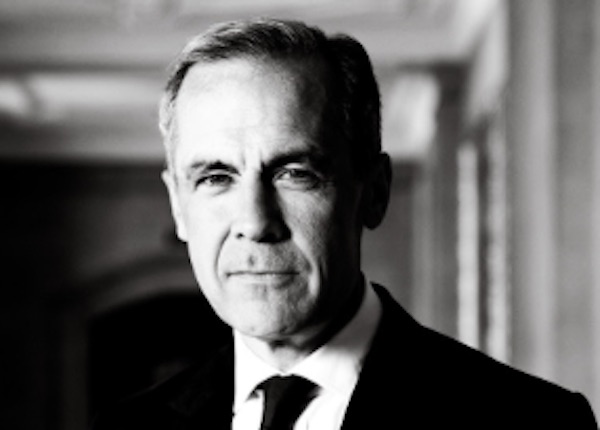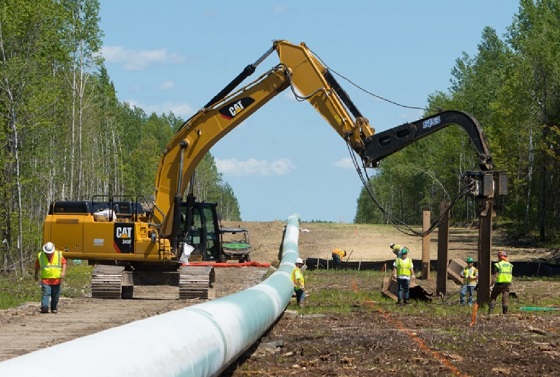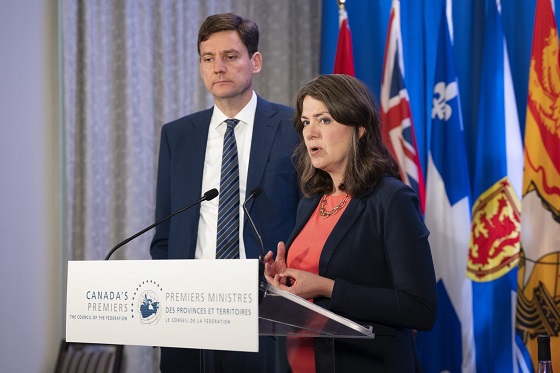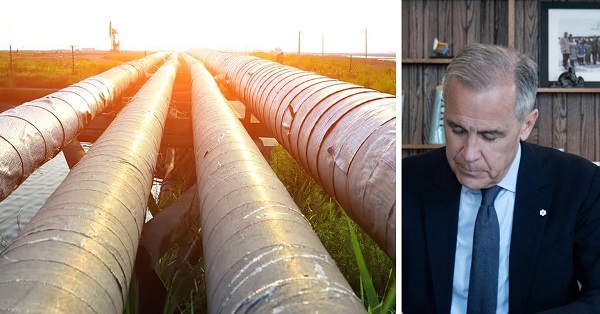Energy
The Real Threat to Banks Isn’t From Climate Change. It’s From Bankers.

Over the last two years, some of the world’s most powerful and influential bankers and investors have argued that climate change poses a grave threat to financial markets and that nations must switch urgently from using fossil fuels to using renewables.
In 2019, the Federal Reserve Bank of San Francisco warned that climate change could cause banks to stop lending, towns to lose tax revenue, and home values to decline. Last year, 36 pension fund managers representing $1 trillion in assets said climate change “poses a systemic threat to financial markets and the real economy.”
And upon taking office, President Joe Biden warned government agencies that climate change disasters threatened retirement funds, home prices, and the very stability of the financial system.
But a major new staff report from the New York Federal Reserve Bank throws cold water on the over-heated rhetoric coming from activist investors, bankers, and politicians. “How Bad Are Weather Disasters for Banks?” asks the title of the report by three economists. “Not very,” they answer in the first sentence of the abstract.
The reason is because “weather disasters over the last quarter century had insignificant or small effects on U.S. banks’ performance.” The study looked at FEMA-level disasters between 1995 and 2018, at county-level property damage estimates, and the impact on banking revenue.
The New York Fed’s authors only looked at how banks have dealt with disasters in the past, and what they wrote isn’t likely to be the final word on the matter. The United Nations Intergovernmental Panel on Climate Change and most other scientific bodies predict that many weather events, including hurricanes and floods, which cause the greatest financial damage, are likely to become more extreme in the future, due to climate change.
And in February, The New York Times quoted one of six United States Federal Reserve governors saying, “Financial institutions that do not put in place frameworks to measure, monitor and manage climate-related risks could face outsized losses on climate-sensitive assets caused by environmental shifts.”
But the Fed economists looked separately at the most extreme 10 percent of all disasters and found that banks impacted not only didn’t suffer, “their income increases significantly with exposure,” and that the improved financial performance of banks hit by disasters wasn’t explained by increased federal disaster (FEMA) aid.
In other words, disasters are actually good for banks, since they increase demand for loans. The larger a bank’s exposure to natural disasters, the larger its profits.
Happily, the profits made by banks are trivial compared to rising societal resilience to disasters, which can be seen by the fact that the share of GDP spent on natural disasters has actually declined over the last 30 years.
While scientists expect hurricanes to become five percent more extreme they also expect them to become 25 percent less frequent, and now, new data showglobal carbon emissions actually declined over the last decade, and thus there is no longer any serious risk of a significant rise in global temperatures.
Banking Against Growth
Biden nominee Saule Omarova said she wants to bankrupt energy companies
The real risk to banks and the global economy comes from climate policy, not climate change, particularly efforts to make energy more expensive and less reliable through the greater use of renewables, new taxes, and new regulations.
“For policymakers,” warned the three economists writing for the New York Fed, “our findings suggest that potential transition risks from climate change warrant more attention than physical disaster risks.”
While they may seem like outliers, they are far from alone in expressing their concern. The second half of the quote by the Fed governor about climate change, which was hyped by The New York Times, warned that banks “could face outsized losses” from the “transition to a low-carbon economy.” (My emphasis.)
And, now concern is growing among members of Congress about the dangers of over-relying on weather-dependent energy, with some members citing the New York Fed’s report after The Wall Street Journal editorialized about it last week .
Proof of the threat to the economy from climate policy is the worst global energy crisis in 50 years. Shareholder activists played a significant role in creating it, according to analysts at Goldman Sachs, Bloomberg, and The Financial Times, by reducing investment in oil and gas production, and causing nations to over-invest in unreliable solar and wind energies, which has driven up energy prices, and contributed significantly to inflation.
And yet a crucial Biden Administration nominee for bank regulation has openly said she would like to bankrupt firms that produce oil and gas, the two fuels whose scarcity is causing the global energy crisis. Progressive academic, Saule Omarova, nominated by Biden, said recently that “we want [oil and gas firms] to go bankrupt” and that “the way we basically get rid of these carbon financiers is we starve them of their source of capital.
Omarova is not an outlier. The Biden Administration’s Financial Stability Oversight Council (FSOC) is advocating 30 new climate regulations that should be imposed on banking. Many analysts believe the US Securities and Exchange Commission will require new regulations. The goal is to radically alter how America’s banks lend money, the energy sector, and the economy as a whole.
And former Bank of England chief, Mark Carney, co-chair of the Glasgow Financial Alliance for Net Zero, has organized $130 trillion in investment and said recently that his investors should expect to make higher, not lower, returns than the market. How? In the exact same way Omarova predicted: by bankrupting some companies, and financing other ones, through government regulations and subsidies.
Carney created the Glasgow Financial Alliance, or GFANZ, with Michael Bloomberg, and they did so under the official seal of the United Nations. “Carney said the alliance will put global finance on a trajectory that ultimately leaves high-carbon assets facing a much bleaker future,” wrote a reporter with Bloomberg. “He also said investors in such products will see the value of their holdings sink.”
What’s going on, exactly? How is it that some of the world’s most powerful bankers, and the politicians they finance, came to support policies that threaten the stability of electrical grids, energy supplies, and thus the global economy itself?
Donate to Environmental Progress
The Unseen Order
Tom Steyer, Michael Bloomberg, and George Soros
Three of the largest donors to climate change causes are billionaire financial titans Michael Bloomberg, George Soros, and Tom Steyer, all of whom have significant investments in both renewables and fossil fuels.
Soros is worth $8 billion and recently made large investments in natural gas firms (EQT) and electric vehicles (Fisker), Bloomberg has a net worth of around $70 billion and has large investments in natural gas and renewables, and much of Steyer’s wealth derives from investments in all three main fossil fuels—coal, oil, and natural gas — as well as renewables.
All three men finance climate activists and politicians, including President Biden, who then seek policies — from $500 billion for renewables and electric vehicles over the next decade to federal control over state energy systems to banking regulations to bankrupt oil and gas companies — which would benefit each of them personally.
Bloomberg gave over $100 million to Sierra Club to lobby to shut down coal plants after he had taken a large stake in its replacement, natural gas, and operates one of the largest news media companies in the world, which publishes articles and sends emails nearly every day reporting that climate change threatens the economy, and that solar panels and wind turbines are the only cost-effective solution.
Soros donates heavily to Center for American Progress, whose founder, John Podesta, was chief of staff to Bill Clinton, campaign chairman for Hillary Clinton’s presidential campaign, and who currently runs policy at the Biden White House. So too does Steyer, who funds the climate activist organization founded by New Yorker author Bill McKibben, 350.org, which reported revenues of nearly $20 million in 2018.
The most influential environmental organization among Democrats and the Biden Administration is the Natural Resources Defense Council, NRDC, which advocated for federal control of state energy markets, the $500 billion for electric cars and renewables, and international carbon markets that would be controlled by the bankers and financiers who also donate to it.
In the 1990s, NRDC helped energy trading company Enron to distribute hundreds of thousands of dollars to environmental groups. “On environmental stewardship, our experience is that you can trust Enron,” said NRDC’s Ralph Cavanagh in 1997, even though Enron executives at the time were defrauding investors of billions of dollars in an epic criminal conspiracy, which in 2001 bankrupted the company.
From 2009 to 2011, NRDC advocated for and helped write complex cap-and-trade climate legislation that would have created and allowed some of their donors to take advantage of a carbon-trading market worth upwards of $1 trillion.
NRDC created and invested $66 million of its own money in a BlackRock stock fund that invested heavily in natural gas companies, and in 2014 disclosed that it had millions invested in renewable funds.
Former NRDC head, Gina McCarthey, now heads up Biden’s climate policy team, and Biden’s top economic advisor, Brian Deese, last worked at BlackRock, and almost certainly will return at the end of the Biden Administration.
Money buys influence. In 2019, McKibben called Steyer a “climate champ” when Steyer announced he was running for president, adding that Steyer’s “just-released climate policy is damned good!” And in 2020, McKibben wrote an article called, “How Banks Could Bail Us Out of the Climate Crisis,” for The New Yorker, which repeated the claim that extreme weather created by climate change threatens financial interests, and that the way to prevent it is to divert public and private money away from reliable energy sources toward weather-dependent ones.
Forms filed to the Internal Revenue Service by Steyer’s philanthropic organization, the TomKat Charitable Trust, show that it gave McKibben’s climate activist group, 350.org, $250,000 in 2012, 2014, and 2015, and may have given money to 350.org in 2013, 2016, 2017, 2018, 2019, and 2020, as well, because 350.org thanked either Steyer’s philanthropy, TomKat Foundation, or his organization, NextGen America, in each of its annual reports since 2013.
At the same time, McKibben’s motivations are plainly spiritual. He claims that various natural disasters are caused by humans, that climate change literally threatens life on Earth, and is thus “greatest challenge humans have ever faced,” a statement so unhinged from reality, considering declining deaths from disasters, declining carbon emissions, and the total absence of any science for such a claim, that it must be considered religious.
McKibben first book about climate change, The End of Nature, explicitly expressed his spiritual views, arguing that, through capitalist industrialization, humankind had lost its connection to nature. “We can no longer imagine that we are part of something larger than ourselves,” he wrote in The End of Nature. “That is what this all boils down to.” Indeed, for William James, the belief in “an unseen order” that we must adjust ourselves to, in order to avoid future punishment, is a defining feature of religion.
Climate change is punishment for our sins against nature — that’s the basic narrative pushed by journalists, climate activists, and their banker sponsors, for 30 years. It has a supernatural element: the belief that natural disasters are getting worse, killing millions, and threatening the economy, when in reality they are getting better, killing fewer, and costing less. And it offers redemption: to avoid punishment we must align our behavior with the unseen order, namely, a new economy controlled by the U.N., bankers, and climate activists. Unfortunately, as is increasingly obvious, the unseen order is parasitical and destructive.
When Nuclear Leads, the Bankers Will Follow
Former German Chancellor Angela Merkel, French President Emanuel Macron, and U.S. Energy Secretary Jennifer Granholm
The unseen order of bankers, climate activists, and the news media is so powerful that it is difficult to imagine how it could ever be challenged.
The financial might of the climate lobby covers the wealth not only of billionaires Soros, Steyer, and Bloomberg, but also $130 trillion in investment funds, including many of the world’s largest pension funds, such as the one belonging to California public employees. The climate lobby’s political power is equally awesome, covering the entirety of the Democratic Party and a significant portion of the Republican Party, and most center-Left parties in Europe.
And all of that is sustained by cultural power, which has led many elites to view climate change as the world’s number one issue, has convinced half of all humans that climate change will make our species extinct, and has served as the apocalyptic foundation for Woke religion.
But serious cracks in the foundation are growing. The global energy crisis has revealed for many around the world the limits of unreliable renewables, with European governments having to subsidize energy to avoid public backlash, President Biden and other heads of state opening up emergency petroleum reserves, and all nations begging OPEC to produce more energy.
The blackouts and rising unreliability of electricity in California, along with the work of the pro-nuclear movement over the last 6 years, has resulted in a growing number of Democrats supporting nuclear energy. Energy Secretary Jennifer Granholm last week publicly urged California Governor Gavin Newsom not to close California’s Diablo Canyon nuclear plant, the signature nuclear plant Environmental Progress has been trying to save since 2016. Democratic support in particular for nuclear is growing.
And alternative media including Substack, podcasts, and social media platforms are increasingly providing a counterweight to the mainstream news media, exposing a huge number of issues that the media got wrong in recent years, and amplifying alternative voices.
Nowhere is the change occurring faster than in Europe, where energy shortages are affecting heating, cooking, and electricity supplies in ways that undermine the legitimacy of the banker-led climate efforts. In Britain, private energy companies have gone bankrupt, forcing the government to bail them out. For-profit energy companies, like banks, ultimately depend on taxpayers, who are also voters.
Outgoing German Chancellor Angela Merkel, who led her nation’s exit from nuclear energy, acknowledged that Germany had been defeated in its anti-nuclear energy advocacy at the European Union level, and that nuclear would finally be recognized as low-carbon.
Donate to Environmental Progress
And French president Emanuel Macron, under pressure from the political right as voters look to elections next year, gave a passionate speech in favor of nuclear energy last month, announcing $35 billion for new reactors.
As the world returns to nuclear, policymakers, media elites, and climate advocates will be increasingly confronted with the question of why consumers and taxpayers will benefit from a global carbon trading scheme and more weather-dependent renewables, particularly at a time of declining global emissions from the continuing transition from coal to natural gas, reduced deforestation, and increased reforestation.
Simply building more nuclear power plants means there is no climate change justification for weather-dependent renewables, which actually require greater use of natural gas, in order to deal with the high amount of unreliability.
Nuclear power goes with slow and patient capital. The obvious funders of a nuclear expansion in the West would be the pension funds, which need the secure return on investment that major construction and infrastructure projects provide, and which unreliable renewables, as the energy crisis shows, do not.
And though the news media is currently ignoring the New York Fed’s report, reporters will not be able to continue spreading misinformation about climate change indefinitely. Increasingly, they, and thus policymakers and the public, will be forced to confront facts inconvenient to their narrative, including that humans are adapting remarkably well to climate change, that renewables make energy unreliable and expensive, and that only nuclear can achieve sustainability goals of reduced emissions, material throughput, and land use.
As people ask, “How Bad Are Weather Disasters?”, not just for banks, but for all of us, the answer will increasingly come back, “Not very.”
Energy
Mistakes and misinformation by experts cloud discussions on energy

From the Fraser Institute
By Jason Clemens and Elmira Aliakbari
The new agreement (MOU) between the Carney and Alberta governments sets the foundation for a pipeline from Alberta to the British Columbia coast, at least conceptually. Unfortunately, many politicians and commentators, including the bureau chiefs for the Globe and Mail and Toronto Star, continue to get many energy facts wrong, which impairs the discussions of how best the country can and should move forward to capitalize on our natural resources.
For example, commentors often wrongly describe the tanker ban on the west coast (C-48) as a general ban on oil tankers. But in reality, the law only applies to tankers docking at Canadian ports. It does not and cannot prevent tankers from travelling the west coast so long as they’re not stationing at Canadian ports. This explains the continued oil tanker traffic in the northwest region for tankers docking in U.S. ports in Alaska. Simply put, there is not a general tanker ban on the west coast.
Commentators also continue to misrepresent the current capacity on the expanded Trans Mountain pipeline (TMX). According to the Canada Energy Regulator (CER), the average utilization of the TMX since it came online in June 2024 is 82 per cent (reaching as high as 89 per cent in March 2025). So, while there’s some room for additional oil transportation via TMX, it’s nowhere close to the “doubling” being discussed in central Canada. Critically, though, according to the CER, from “June 2024 to June 2025, committed capacity was effectively fully utilized each month, averaging 99% utilization.”
Similarly, there’s a misunderstanding by many in central Canada regarding the potential restart of the Keystone XL pipeline, which apparently President Trump is keen on. Keystone would not diversify Canada’s exports because while oil does make its way down to the southern U.S. where it can be exported, the actual sale of Canadian oil is to U.S. refineries, so our reliance on the U.S. as our near-sole export market would continue unless a west and/or east coast pipeline is developed.
There also continues to be an artificial and costly connection made between Ottawa removing the arbitrary emissions cap on greenhouse gases by the oil and gas sector and the approval of a new pipeline with the proposed Pathways carbon capture project, which is a collaboration between five of Canada’s largest oil producers. This connection was galvanized in the MOU.
The idea behind the project is to reduce (conceptually) the amount of greenhouse gas (GHG) emitted from oil extraction and transportation projects linked with Pathways. The Pathways project produces no economic value or product—it simply collects and stores GHG emissions—and reports suggest the total cost for the first phase of the project will reach $16.5 billion.
Should Canadians care about adding costs related to GHG mitigation? There are several factors to consider. First, Canada is already a low-GHG emitting producer of oil. According to the Carney government’s first budget (page 105, chart 1.5 which ranks the world’s 20 top oil producers based on their GHG emissions per unit of output), Canada already ranks 7th-lowest in terms of emissions. And more importantly, it’s lower than every country—Venezuela, Russia, Iraq and Mexico—that produces a similar type of oil as Canada. Any resources spent further reducing GHG emissions via carbon capture will result in small incremental gains contrasted with large costs (again, at least $16.5 billion). A number of analysts have already raised concerns about the investment and competitiveness implications of increasing the cost structures for Alberta producers.
Second, according to the federal government, in 2022 Canada produced 1.4 per cent of global GHG emissions, and the oil and gas sector produced roughly one-quarter of those emissions. In other words, if Canada eliminated all GHG emissions from the oil sector via carbon capture, the process would consume vast amounts of scarce resources (i.e. money) and result in a nearly undetectable change in global GHG emissions. One can only conclude that this is much more about international virtue-signalling than the actual economics and environmental implications of Canada’s potential energy projects.
At a time when Canada is struggling with crisis levels of private business investment, falling living standards and as the Bank of Canada described, a break-the-glass crisis in productivity growth, it’s clearly not wise to spend tens of billions of dollars on projects that might make politicians and bureaucrats feel better and enable them to use near Orwellian language like “zero-emissions oil” but that actually deliver almost no detectable environmental benefits.
To borrow our prime minister’s favourite phrase, kickstarting Canada’s oil and gas sector is the easiest way to catalyze economic growth given our vast energy reserves, know-how in the sector, and high productivity. To do so, we need a national dialogue rooted in facts.
Energy
Ottawa and Alberta’s “MOU” a step in the right direction—but energy sector still faces high costs and weakened competitiveness

From the Fraser Institute
By Tegan Hill and Elmira Aliakbari
The Memorandum of Understanding (MOU) between Alberta Premier Danielle Smith and Prime Minister Mark Carney, which includes a new oil pipeline to BC’s northwest coast, offers some hope for Canada’s energy future. While this agreement is a step in the right direction, it puts Alberta’s energy sector on the hook to secure access to new markets while facing higher costs and reduced competitiveness.
Earlier this year, Smith demanded then-newly elected Prime Minister Carney repeal nine “bad laws” stifling oil and gas investment, which has collapsed by nearly 61 per cent in the province since 2014, falling from $64.7 billion to $25.4 billion in 2024 (inflation-adjusted).
One key policy on the list was the proposed federal emissions cap, which would have applied exclusively to the oil and gas sector. According to the MOU, Canada will not move forward with the cap, which is a welcome change. Indeed, multiple analyses showed that the cap would have inevitably resulted in a production cut, costing the economy billions and resulting in tens of thousands of job losses. And, with oil and gas demand continuing to climb, the cap would have shifted production to other countries with lower environmental and human rights standards such as Iran, Russia and Venezuela.
Scrapping the Clean Electricity Regulations (CER) was also one of Smith’s demands. While the MOU states that “Canada and Alberta remain committed to achieving net zero greenhouse gas emissions by 2050”, the CER as it applies to the province will be suspended for the time being. Again, this is a critical and positive change for a province where 85 per cent of its electricity comes from fossil fuels—a larger share than nearly any other province. (For perspective, in Quebec, over 85 per cent of its electricity comes from hydro.) The Alberta Electric System Operator (AESO) estimates it would cost $44 to $54 billion to decarbonize Alberta’s grid by 2041—a 30 to 36 per cent spending increase—costs that ultimately fall on consumers.
A third key policy on Smith’s list of nine bad laws was repealing Bill C-48, which banned large oil tankers off BC’s northern coast from docking in Canadian ports. According to the MOU, there may be a limited exemption to the ban. Specifically, it states that to enable the export of bitumen there may be an “appropriate adjustment.” The law effectively prevents Canadian producers from accessing Asia and other international markets. Crucially, the legislation applies only to tankers docking in Canadian ports—U.S. and foreign tankers continue to operate freely in the same waters accessing U.S. ports. In other words, the law exclusively hinders Canada’s competitiveness—creating a carve out for one pipeline will not fix this problem.
All of these policy changes or exemptions are conditional on stronger industrial carbon pricing and support for the massive multibillion-dollar Pathways project–a 400-kilometer pipeline transporting carbon trapped at oil facilities to an underground storage facility near Cold lake Alberta and led by a group of Canada’s five largest oil companies. Earlier this year, Alberta froze its industrial carbon tax at $95 per tonne through 2026, but the MOU states that the system will ramp up to a minimum price of $130/tonne. This will increase the cost of producing, processing and transporting oil, at a time when a surge in global oil production and downward pressure on oil prices is expected. Ultimately, this will widen the competitiveness gap between Alberta and many other jurisdictions, such as the United States, that do not have comparable carbon pricing in place.
The agreement is also conditional on the $16.5 billion (minimum estimate) Pathways project to capture, sequester and store carbon underground. Adding carbon capture technology would increase production costs by roughly US $1.2-$3 per barrel for oil sands mining operations and US $3.6-$4.8 for oil sands facilities that use steam. These higher costs further erode the province’s competitiveness and won’t help in attracting private sector investment.
The memorandum of understanding makes some important strides for Canada’s energy future and is certainly an improvement on the status quo, but it still leaves Alberta’s energy sector facing higher costs and weakened competitiveness, and more broadly doesn’t remove the many impediments to large-scale development of our oil sector.
-

 Agriculture2 days ago
Agriculture2 days agoHealth Canada indefinitely pauses plan to sell unlabeled cloned meat after massive public backlash
-

 Energy15 hours ago
Energy15 hours agoPoilievre says West Coast Pipeline MOU is no guarantee
-

 Carbon Tax19 hours ago
Carbon Tax19 hours agoCanadian energy policies undermine a century of North American integration
-

 Alberta16 hours ago
Alberta16 hours agoWest Coast Pipeline MOU: A good first step, but project dead on arrival without Eby’s assent
-

 Energy14 hours ago
Energy14 hours agoWill the New West Coast Pipeline MoU Lead to Results? Almost Certainly Not According to AI
-

 Alberta14 hours ago
Alberta14 hours agoCarney forces Alberta to pay a steep price for the West Coast Pipeline MOU
-

 Alberta18 hours ago
Alberta18 hours agoAlberta and Ottawa ink landmark energy agreement
-

 Crime2 days ago
Crime2 days agoFBI Seizes $13-Million Mercedes Unicorn From Ryan Wedding’s Narco Network











